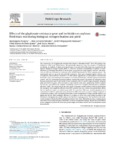Use este identificador para citar ou linkar para este item:
http://www.alice.cnptia.embrapa.br/alice/handle/doc/977903| Título: | Effects of the glyphosate-resistance gene and herbicides on soybean: field trials monitoring biological nitrogen fixation and yield. |
| Autoria: | HUNGRIA, M.  MENDES, I. C.   NAKATANI, A. S.   REIS-JUNIOR, F. B. dos   MORAIS, J. Z.   OLIVEIRA, M. C. N. de   FERNANDES, M. F.   |
| Afiliação: | MARIANGELA HUNGRIA DA CUNHA, CNPSO IEDA DE CARVALHO MENDES, CPAC ANDRÉ SHIGUEYOSHI NAKATANI FABIO BUENO DOS REIS JUNIOR, CPAC JOSE ZUCCA MORAIS, CNPSO MARIA CRISTINA NEVES DE OLIVEIRA, CNPSO MARCELO FERREIRA FERNANDES, CPATC. |
| Ano de publicação: | 2014 |
| Referência: | Field Crops Research, v. 158, p. 43-54, 2014. |
| Conteúdo: | The commercial use of glyphosate-resistant (also known as Roundup Ready®, GR or RR) soybean wasinitiated in 1996 in the United States. This genetically engineered crop now occupies 75.4 million haworldwide, 20.6 million of which are in Brazil where it occupies 86% of the total area cropped with thelegume. Biological nitrogen fixation (BNF) is critical for economic sustainability of soybean in Brazil;therefore, to investigate the effects of the RR gene?using pairs of nearly isogenic cultivars?and herbi-cides on BNF, we conducted an extensive series of field experiments for three cropping seasons. Theexperiments were set up at six sites with five treatments, three pairs of nearly isogenic cultivars, andsix replicates. The treatments consisted of: (T1) RR soybean + glyphosate; (T2) RR soybean + conventionalherbicides; (T3) conventional parental soybean + conventional herbicides; (T4) RR soybean + hand weedcontrol; and (T5) conventional parental soybean + hand weed control. Parameters of nodulation, plantbiomass production, total N and ureide-N were evaluated at the V4 and R2 stages of growth, and grainyield and total N in grains were evaluated at crop maturity. Data were analyzed by ANOVA, analysesof contrasts, and multivariate analyses considering a pool of six variables, denominated as symbioticefficiency (SyEf). The comparison of the pairs of non-transgenic and RR soybean cultivars showed thatthe transgenic trait negatively affected some BNF variables, but over a three-year period these effectshad no significant impact on soybean grain yield. No consistent differences between glyphosate andconventional herbicide application were observed on BNF-associated parameters. When compared toconventional soybean and conventional herbicides, weed-management strategy with RR soybean andglyphosate did not affect symbiotic efficiency. In addition, at three sites, grain yields increased in thetreatments with glyphosate and RR soybean over the three cropping seasons. The results from the multi-variate analyses indicate that BNF and yield parameters were more affected by location, cropping seasonand cultivar than by the transgene, herbicides, or weed-management strategy. Despite the lack of effectsof the transgene on yield in the three-year period, longer-term effects on BNF and N accumulation shouldbe monitored. |
| Thesagro: | Soja Herbicida Fixação de nitrogênio |
| NAL Thesaurus: | Soybeans Herbicides Nitrogen fixation |
| Digital Object Identifier: | 10.1016/j.fcr.2013.12.022 |
| Tipo do material: | Artigo de periódico |
| Acesso: | openAccess |
| Aparece nas coleções: | Artigo em periódico indexado (CNPSO)  |
Arquivos associados a este item:
| Arquivo | Descrição | Tamanho | Formato | |
|---|---|---|---|---|
| hungria.fieldcropsresearch.pdf | 1,2 MB | Adobe PDF |  Visualizar/Abrir |









